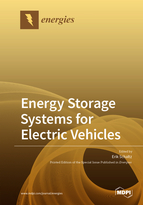Energy Storage Systems for Electric Vehicles
A special issue of Energies (ISSN 1996-1073). This special issue belongs to the section "E: Electric Vehicles".
Deadline for manuscript submissions: closed (15 March 2020) | Viewed by 97374
Special Issue Editor
Interests: application of power electronics, electric machines, fuel cells, batteries, ultracapacitors, etc. in electric and hybrid electric vehicles; battery state-estimation, management (electric and thermal), and modelling (electric, thermal, and lifetime) of battery cells and packs
Special Issues, Collections and Topics in MDPI journals
Special Issue Information
Dear Colleagues,
The global electric car fleet has now exceeded 5 million and will continue to increase in the future, as electrification is an important means of decreasing the greenhouse gas emissions of the transportation sector.
The energy storage system is a very central component of the electric vehicle. The storage system needs to be cost-competitive, light, efficient, safe, and reliable, and to occupy little space and last for a long time. It should also be produced and disposed of in an environmentally friendly manner. This leaves many research challenges, and the purpose of this Special Issue is therefore to provide a platform for sharing the latest findings on energy storage systems for electric vehicles (electric cars, buses, aircraft, ships, etc.).
Research in energy storage systems requires several sciences working together, and we therefore welcome contributions from many different disciplines. Topics of interest include but are not limited to the following:
- Battery-management systems;
- State-of-charge and state-of-health estimation;
- Lifetime studies;
- Thermal-battery-management systems;
- Thermal energy storage for battery and/or cabin heating;
- Packaging of battery cells;
- Emerging battery technologies;
- Alternative energy storage systems, e.g., hybrid supercapacitor, supercapacitor/battery combinations, etc;
- Power electronics for energy storage devices;
- Life cycle analysis;
- Recycling of batteries.
Assoc. Prof. Erik Schaltz
Guest Editor
Manuscript Submission Information
Manuscripts should be submitted online at www.mdpi.com by registering and logging in to this website. Once you are registered, click here to go to the submission form. Manuscripts can be submitted until the deadline. All submissions that pass pre-check are peer-reviewed. Accepted papers will be published continuously in the journal (as soon as accepted) and will be listed together on the special issue website. Research articles, review articles as well as short communications are invited. For planned papers, a title and short abstract (about 100 words) can be sent to the Editorial Office for announcement on this website.
Submitted manuscripts should not have been published previously, nor be under consideration for publication elsewhere (except conference proceedings papers). All manuscripts are thoroughly refereed through a single-blind peer-review process. A guide for authors and other relevant information for submission of manuscripts is available on the Instructions for Authors page. Energies is an international peer-reviewed open access semimonthly journal published by MDPI.
Please visit the Instructions for Authors page before submitting a manuscript. The Article Processing Charge (APC) for publication in this open access journal is 2600 CHF (Swiss Francs). Submitted papers should be well formatted and use good English. Authors may use MDPI's English editing service prior to publication or during author revisions.
Keywords
- battery-management systems
- thermal-battery-management systems
- state-of-charge
- state-of-health
- emerging batteries
- thermal energy storage
- life cycle analysis
- recycling






